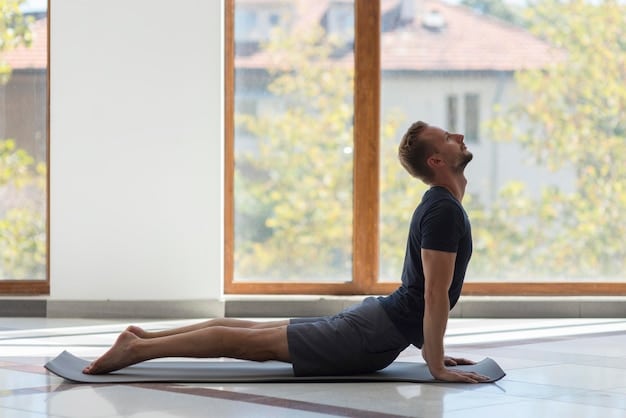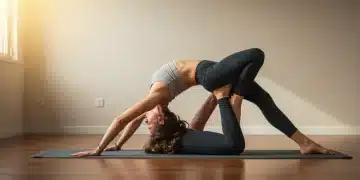Avoid Yoga Injuries: Expert Tips on Common Posture Mistakes

Avoid these 5 common yoga posture mistakes that can lead to injury through expert advice, focusing on alignment and mindful movement, ensuring a safe and effective yoga practice.
Embarking on a yoga journey promises enhanced flexibility, strength, and mental well-being. However, improper alignment and technique can lead to injuries. Let’s delve into how to avoid these 5 common yoga posture mistakes that can lead to injury, ensuring a safe and fulfilling yoga practice.
Understanding the Importance of Proper Alignment
Proper alignment is crucial in yoga. It’s not just about achieving the final pose but also about maintaining safety and effectiveness throughout the practice. Poor alignment can strain joints, compress nerves, and lead to chronic pain. Understanding the foundations of correct posture is the first step in preventing yoga-related injuries.
Why Alignment Matters
Alignment optimizes the distribution of weight and balances muscular effort. This ensures that the right muscles are engaged, and no undue stress is placed on vulnerable areas. Consider alignment as the architecture of your pose. If the foundation is shaky, the entire structure is compromised.
Furthermore, understanding proper alignment deepens the mind-body connection. When you are acutely aware of your posture, you are more present in the moment. Yoga transcends physical exercise; it becomes a practice of mindfulness, promoting both physical and mental well-being.
- Prevents strain and injury by distributing weight properly.
- Engages the correct muscles, enhancing the effectiveness of the pose.
- Deepens the mind-body connection through increased awareness.
- Promotes long-term joint health and reduces the risk of chronic pain.
Focusing on proper alignment transforms yoga into a sustainable practice, allowing you to reap its benefits for years to come. It’s not about pushing your body to its limits but about working intelligently within your own unique range of motion.
Mistake 1: Rounding the Back in Forward Folds
Forward folds are common in yoga, but rounding the back during these poses is a frequent mistake. This can place excessive stress on the lumbar spine, leading to lower back pain. To avoid this, focus on maintaining a straight spine throughout the movement.

How to Correct It
Engage your core muscles. This support will help maintain a straight spine. You can also bend your knees slightly to reduce tension in your hamstrings. It’s more important to keep your spine straight than to touch your toes.
Another helpful technique is to visualize lengthening your spine as you fold forward. Imagine creating space between each vertebra. This visualization can help you maintain a healthy spinal curve. Practicing in front of a mirror can also provide visual feedback on your alignment.
- Engage your core muscles for spinal support.
- Bend your knees slightly to reduce hamstring tension.
- Visualize lengthening your spine during the fold.
- Use a mirror for visual feedback on your posture.
By focusing on these adjustments, you can transform your forward folds into safe and beneficial poses, promoting spinal health and preventing lower back pain. Remember, it’s about progress, not perfection.
Mistake 2: Hyperextending the Knees in Standing Poses
Hyperextension of the knees occurs when the knee joint extends beyond its normal range of motion, often locking the joint. This is common in standing poses like Tadasana (Mountain Pose) and Virabhadrasana I (Warrior I). Hyperextension can weaken the knee joint over time, leading to instability and pain.
The Dangers of Hyperextension
Hyperextension places undue stress on the ligaments and cartilage of the knee. Over time, this can lead to chronic pain, inflammation, and even osteoarthritis. It also disrupts the alignment of the entire leg, affecting the hips and ankles.
Many people hyperextend their knees without even realizing it. This is because the habit often develops unconsciously over time, especially in those with naturally flexible joints. However, awareness is the first step in correcting this potentially harmful pattern.
To protect your knees, focus on maintaining a micro-bend in your knees during standing poses. This activates the muscles around the knee joint, providing stability and preventing hyperextension. Imagine gently drawing your kneecaps upward, engaging your quadriceps.
Mistake 3: Misaligning the Shoulders in Plank Pose
Plank pose is a foundational pose that builds core strength and stability. However, many people misalign their shoulders in plank, either dropping them too low or hunching them up towards their ears. This misalignment can strain the shoulder joint and lead to rotator cuff injuries.
Proper Shoulder Alignment in Plank
The key to proper shoulder alignment in plank is to keep your shoulders directly over your wrists. Engage your core muscles to maintain a straight line from your head to your heels. Avoid letting your hips sag or lift too high.
Imagine pressing the floor away from you. Activating your serratus anterior, the muscle along the side of your rib cage, helps stabilize the scapula and prevent winging. This ensures that your shoulders are properly engaged and protected.
- Keep shoulders directly over wrists.
- Engage core muscles to maintain a straight line.
- Press the floor away to activate serratus anterior.
- Avoid sagging hips or hunching shoulders.
Practicing plank in front of a mirror can help you monitor your shoulder alignment. If you notice your shoulders dropping or hunching, adjust your position accordingly. Remember, it’s better to modify the pose to maintain proper form than to push yourself into a position that could lead to injury.
Mistake 4: Overarching the Back in Cobra Pose
Cobra pose is a gentle backbend that opens the chest and strengthens the spine. However, overarching the back in cobra can compress the lumbar vertebrae and lead to lower back pain. To avoid this, focus on engaging your back muscles and lifting from the upper back.

The Safe Way to Practice Cobra
Start by pressing your hands into the floor and drawing your shoulders back and down. Engage your back muscles to lift your chest off the floor, keeping your lower ribs grounded. Avoid pushing excessively with your hands, which can lead to overextension.
Visualize lengthening your spine as you lift. Imagine drawing your tailbone down towards your heels to create space in the lumbar region. This helps prevent compression and allows for a more supported backbend.
If you’re new to cobra pose, start with a lower variation. Focus on maintaining proper alignment and engaging your back muscles. As your strength and flexibility improve, you can gradually increase the intensity of the backbend.
Mistake 5: Holding Your Breath During Poses
Breath is an integral part of yoga. Holding your breath during poses can increase tension, limit flexibility, and disrupt the flow of energy in the body. It’s essential to maintain a steady, rhythmic breath throughout your practice.
Connecting Breath to Movement
Coordinate your breath with your movements. Inhale as you expand and lengthen; exhale as you contract and release. For example, inhale as you lift your arms overhead and exhale as you fold forward. This synchronization enhances the mind-body connection and promotes relaxation.
If you find yourself holding your breath, it’s a sign that you’re pushing yourself too hard. Modify the pose or take a break until your breath returns to normal. Yoga is not about forcing your body into uncomfortable positions; it’s about finding ease and stability within each pose.
- Coordinate breath with movements.
- Inhale as you expand; exhale as you contract.
- Modify poses if you’re holding your breath.
- Focus on finding ease and stability.
By paying attention to your breath, you can deepen your yoga practice and unlock its full potential. Breath awareness is a powerful tool for managing stress, increasing energy, and cultivating inner peace.
| Key Point | Brief Description |
|---|---|
| ⚠️ Rounding Back | Avoid rounding the back in forward folds to prevent lower back pain. |
| 🦵 Hyperextending Knees | Maintain a micro-bend in knees during standing poses to protect the knee joint. |
| 🧘 Shoulder Alignment | Align shoulders properly in plank to avoid strain and potential rotator cuff injuries. |
| 🌬️ Holding Breath | Focus on breathing steadily during poses to release tension and promote relaxation. |
Frequently Asked Questions
▼
Proper alignment in yoga is critically important as it helps to distribute weight evenly, preventing undue stress on joints and muscles. It enhances pose effectiveness and reduces the risk of injuries during practice.
▼
To correct rounding your back in forward folds, engage your core and keep a slight bend in your knees. Focus on lengthening your spine and hinging from the hips rather than forcing yourself to touch your toes.
▼
Hyperextending your knees can lead to joint instability, pain, and increase the risk of developing osteoarthritis over time. It places unnecessary stress on the ligaments and cartilage surrounding the knee.
▼
In plank pose, your shoulders should be aligned directly over your wrists. Engage your core to maintain a straight line from head to heels, avoiding the collapse of your chest or hunching your shoulders towards your ears.
▼
Breathing properly in yoga is crucial for reducing tension, enhancing flexibility, and promoting a smooth energy flow throughout the body. It helps deepen your connection to the practice and contributes to overall well-being.
Conclusion
Avoiding these common yoga posture mistakes is essential for a safe and effective practice. By focusing on proper alignment, engaging the correct muscles, and maintaining a steady breath, you can prevent injuries and reap the full benefits of yoga. Remember, it’s not about achieving the perfect pose but about mindful movement and respecting your body’s limitations.





